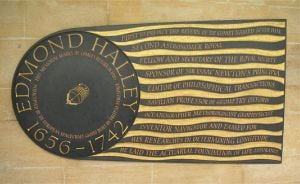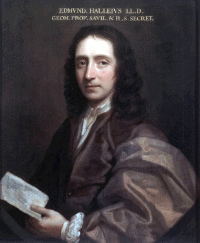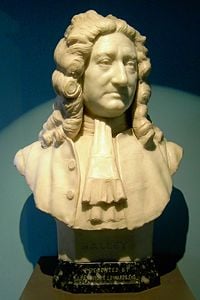Encyclopedia, Difference between revisions of "Edmond Halley" - New World
(imported latest version of article from Wikipedia) |
|||
| Line 1: | Line 1: | ||
| − | [[Image: Edmund_Halley.gif|200px|right|thumb| Portrait of Edmond Halley painted around | + | {{Claimed}} |
| + | {{epname}} | ||
| + | [[Image: Edmund_Halley.gif|200px|right|thumb| Portrait of Edmond Halley painted around 1687 by [[Thomas Murray (artist)|Thomas Murray]] ([[Royal Society]], London)]] | ||
[[Image:Edmond Halley 5.jpg|thumb|200px|Portrait of Edmond Halley]] | [[Image:Edmond Halley 5.jpg|thumb|200px|Portrait of Edmond Halley]] | ||
[[Image:Edmond Halley Royal Greenwich Observatory Museum.jpg|thumb|200px|Bust of Edmond Halley in the Museum of the [[Royal Observatory, Greenwich|Royal Greenwich Observatory]]]] | [[Image:Edmond Halley Royal Greenwich Observatory Museum.jpg|thumb|200px|Bust of Edmond Halley in the Museum of the [[Royal Observatory, Greenwich|Royal Greenwich Observatory]]]] | ||
| − | '''Edmond Halley''' [[Royal Society|FRS]] (sometimes "Edmund" | + | '''Edmond Halley''' [[Royal Society|FRS]] (sometimes "Edmund," November 8, 1656 – January 14, 1742) was an [[England|English]] [[astronomer]], [[geophysicist]], [[mathematician]], [[meteorologist]], and [[physicist]]. |
==Biography and career == | ==Biography and career == | ||
| − | Halley was born at [[Haggerston]], [[London]], the son of a wealthy soapboiler. As a child, he was very interested in mathematics. He studied at [[St Paul's School]], and then from | + | Halley was born at [[Haggerston]], [[London]], the son of a wealthy soapboiler. As a child, he was very interested in mathematics. He studied at [[St Paul's School]], and then from 1673 at [[The Queen's College, Oxford]]. Whilst an [[undergraduate]] he published papers on the [[solar system]] and [[sunspot]]s. |
| − | On leaving [[University of Oxford|Oxford]], in | + | On leaving [[University of Oxford|Oxford]], in 1676, he visited the south Atlantic island of [[St. Helena]] with the intention of studying stars from the Southern Hemisphere. He returned to England in November 1678. In the following year he published ''Catalogus Stellarum Australium'' which included details of 341 southern stars. These additions to the [[star map]] earned him comparison with [[Tycho Brahe]]. He was awarded his M.A. degree at Oxford and elected as a Fellow of the [[Royal Society]]. |
| − | In | + | In 1686 Halley published the second part of his expedition, being a paper and chart on [[trade wind]]s and [[monsoon]]s. In this he identified solar heating as the cause of [[Earth's atmosphere|atmospheric]] motions. He also established the relationship between [[barometer|barometric pressure]] and height above [[sea level]]. His charts were an important contribution to the emerging field of [[information visualization]]. |
| − | Halley married in | + | Halley married in 1682 and settled in [[Islington]]. He spent most of his time on lunar observations, but was also interested in the problems of [[gravity]]. One problem that attracted his attention was the proof of [[Kepler's laws of planetary motion]]. In August 1684 he went to [[University of Cambridge|Cambridge]] to discuss this with [[Isaac Newton]], only to find that Newton had solved the problem but published nothing. Halley convinced him to write the ''[[Principia Mathematica Philosophiae Naturalis]]'' (1687), which was published at Halley's expense. |
| − | In | + | In 1690, Halley built a [[diving bell]], in which device the atmosphere was replenished by way of weighted barrels of air sent down from the surface. In a demonstration, Halley and five companions dived to 60 feet in the [[River Thames]], and remained there for over one and a half hours. Halley's bell was of little use for practical salvage work, as it was very heavy, but he did make improvements to his bell over time, later extending his underwater exposure time to over 4 hours.<ref><cite>[http://www.londondivingchamber.co.uk/index.php?id=history&page=4 London Diving Chamber (history)] accessed on 6th Dec 2006</ref> |
| − | In | + | In 1693 he published an article on life annuities, which featured an analysis of age-at-death taken from the records of [[Wrocław|Breslau]], a Polish-German town known for keeping meticulous records. This allowed the British government to sell life annuities at an appropriate price based on the age of the purchaser. Halley's work strongly influenced the development of [[actuarial science]]. The construction of the life-table for Breslau, which followed more primitive work by [[John Graunt]], is now seen as a major event in the history of [[demography]]. |
| − | In | + | In 1698 he received a commission as captain of HMS ''Paramore'' to make extensive observations on the conditions of terrestrial [[magnetism]]. This task he accomplished in an Atlantic voyage which lasted two years, and extended from 52 degrees north to 52 degrees south. The results were published in a ''General Chart of the Variation of the Compass'' (1701). This was the first such chart to be published and the first on which [[Isogon (geomagnetism)|isogonic]], or Halleyan, lines appeared. |
| − | In November | + | In November 1703 he was appointed Savilian professor of [[geometry]] at Oxford University, and received an honorary degree of doctor of laws in 1710. In 1705, applying [[historical astronomy]] methods, he published ''Synopsis Astronomia Cometicae'', which stated his belief that the comet sightings of 1456, 1531, 1607, and 1682 related to the same comet, which he predicted would return in 1758. When it did it became generally known as [[Halley's Comet]]. |
| − | In | + | In 1716 Halley suggested a high-precision measurement of the distance between the Earth and the Sun by timing the [[transit of Venus]]. In doing so he was following the method described by [[James Gregory (astronomer and mathematician)|James Gregory]] in ''[[Optica Promota]]'' (in which the design of the Gregorian telescope is also described). It is reasonable to assume Halley possessed and had read this book given that the Gregorian design was the principal telescope design used in astronomy in Halley's day. It is not to Halley's credit that he failed to acknowledge Gregory's priority in this matter. In 1718 he discovered the [[proper motion]] of the "fixed" stars by comparing his [[astrometry|astrometric]] measurements with those of the Greeks. |
| − | In | + | In 1720, Halley succeeded [[John Flamsteed]] as [[Astronomer Royal]], a position which he held until his death. He was buried at St. Margaret's Church in [[Lee, London|Lee]] in south-east [[London]]. |
==Hollow Earth== | ==Hollow Earth== | ||
| − | In | + | In 1692 (''Philosophical Transactions of [[Royal Society of London]]''), Halley put forth the idea of a [[hollow Earth]] consisting of a shell about 500 miles (800 km) thick, two inner concentric shells and an innermost core, about the diameters of the planets [[Venus]], [[Mars]], and [[Mercury (planet)|Mercury]]. Atmospheres separate these shells, and each shell has its own magnetic poles. The spheres rotate at different speeds. Halley proposed this scheme in order to explain anomalous compass readings. He envisaged the [[Celestial body atmosphere|atmosphere]] inside as [[luminosity|luminous]] (and possibly inhabited) and speculated that escaping gas caused the [[Aurora Borealis]].<ref>{{cite web|last=Carroll|first=Robert Todd|authorlink=Robert Todd Carroll|year=2006-02-13|url=http://skepdic.com/hollowearth.html|title=hollow Earth|work=[[Skeptic's Dictionary|The Skeptic's Dictionary]]|accessdate=2006-07-23}}</ref> |
== Named after Halley == | == Named after Halley == | ||
| − | [[Image:Edmond Halley plaque in Westminster Abbey.jpg|right|thumb|Plaque in South Cloister of [[Westminster Abbey]]]] | + | [[Image:Edmond Halley plaque in Westminster Abbey.jpg|right|thumb|Plaque in South Cloister of [[Westminster Abbey]].]] |
| + | |||
* [[Comet Halley|Halley's Comet]] — Halley predicted the comet's return. | * [[Comet Halley|Halley's Comet]] — Halley predicted the comet's return. | ||
* [[Halley (crater)|Halley crater]] on [[Mars (planet)|Mars]] | * [[Halley (crater)|Halley crater]] on [[Mars (planet)|Mars]] | ||
| Line 36: | Line 39: | ||
* [[Halley Research Station]], [[Antarctica]] | * [[Halley Research Station]], [[Antarctica]] | ||
| − | + | == Notes == | |
| + | <references /> | ||
| − | + | ==References== | |
| − | + | <<We need at least 3 reliable references here, properly formatted.>> | |
| − | |||
| − | |||
| − | |||
| − | |||
| − | |||
| − | |||
| − | + | * Alan H. Cook, ''Edmond Halley: Charting the Heavens and the Seas'' (Clarendon Press, 1998) | |
| − | |||
| − | |||
==External links== | ==External links== | ||
| − | + | ||
*[http://www.pierre-marteau.com/editions/1693-mortality.html Edmond Halley, An Estimate of the Degrees of the Mortality of Mankind (1693).] | *[http://www.pierre-marteau.com/editions/1693-mortality.html Edmond Halley, An Estimate of the Degrees of the Mortality of Mankind (1693).] | ||
*[http://adsabs.harvard.edu/cgi-bin/nph-bib_query?bibcode=1942ASPL....4..103A Edmond Halley, Considerations on the Changes of the Latitudes of Some of the Principal Fixed Stars (1718). Reprinted in R.G. Aitken, Edmund Halley and Stellar Proper Motions (1942)] | *[http://adsabs.harvard.edu/cgi-bin/nph-bib_query?bibcode=1942ASPL....4..103A Edmond Halley, Considerations on the Changes of the Latitudes of Some of the Principal Fixed Stars (1718). Reprinted in R.G. Aitken, Edmund Halley and Stellar Proper Motions (1942)] | ||
| Line 62: | Line 58: | ||
{{DEFAULTSORT:Halley, Edmond}} | {{DEFAULTSORT:Halley, Edmond}} | ||
| − | [[Category: | + | [[Category:Physical sciences]] |
| − | [[Category: | + | [[Category:Biographies of Scientists and Mathematicians]] |
| − | + | [[Category:Biography]] | |
| − | |||
| − | |||
| − | |||
| − | |||
| − | |||
| − | |||
| − | |||
| − | |||
| − | [[Category: | ||
| − | + | {{credit|129085051}} | |
| − | |||
| − | |||
| − | |||
| − | |||
| − | |||
| − | |||
| − | |||
| − | |||
| − | |||
| − | |||
| − | |||
| − | |||
| − | |||
| − | |||
| − | |||
| − | |||
| − | |||
| − | |||
| − | |||
| − | |||
| − | |||
| − | |||
| − | |||
| − | |||
| − | |||
| − | |||
| − | |||
| − | |||
| − | |||
| − | |||
| − | |||
Revision as of 19:35, 10 May 2007
Edmond Halley FRS (sometimes "Edmund," November 8, 1656 – January 14, 1742) was an English astronomer, geophysicist, mathematician, meteorologist, and physicist.
Biography and career
Halley was born at Haggerston, London, the son of a wealthy soapboiler. As a child, he was very interested in mathematics. He studied at St Paul's School, and then from 1673 at The Queen's College, Oxford. Whilst an undergraduate he published papers on the solar system and sunspots.
On leaving Oxford, in 1676, he visited the south Atlantic island of St. Helena with the intention of studying stars from the Southern Hemisphere. He returned to England in November 1678. In the following year he published Catalogus Stellarum Australium which included details of 341 southern stars. These additions to the star map earned him comparison with Tycho Brahe. He was awarded his M.A. degree at Oxford and elected as a Fellow of the Royal Society.
In 1686 Halley published the second part of his expedition, being a paper and chart on trade winds and monsoons. In this he identified solar heating as the cause of atmospheric motions. He also established the relationship between barometric pressure and height above sea level. His charts were an important contribution to the emerging field of information visualization.
Halley married in 1682 and settled in Islington. He spent most of his time on lunar observations, but was also interested in the problems of gravity. One problem that attracted his attention was the proof of Kepler's laws of planetary motion. In August 1684 he went to Cambridge to discuss this with Isaac Newton, only to find that Newton had solved the problem but published nothing. Halley convinced him to write the Principia Mathematica Philosophiae Naturalis (1687), which was published at Halley's expense.
In 1690, Halley built a diving bell, in which device the atmosphere was replenished by way of weighted barrels of air sent down from the surface. In a demonstration, Halley and five companions dived to 60 feet in the River Thames, and remained there for over one and a half hours. Halley's bell was of little use for practical salvage work, as it was very heavy, but he did make improvements to his bell over time, later extending his underwater exposure time to over 4 hours.[1]
In 1693 he published an article on life annuities, which featured an analysis of age-at-death taken from the records of Breslau, a Polish-German town known for keeping meticulous records. This allowed the British government to sell life annuities at an appropriate price based on the age of the purchaser. Halley's work strongly influenced the development of actuarial science. The construction of the life-table for Breslau, which followed more primitive work by John Graunt, is now seen as a major event in the history of demography.
In 1698 he received a commission as captain of HMS Paramore to make extensive observations on the conditions of terrestrial magnetism. This task he accomplished in an Atlantic voyage which lasted two years, and extended from 52 degrees north to 52 degrees south. The results were published in a General Chart of the Variation of the Compass (1701). This was the first such chart to be published and the first on which isogonic, or Halleyan, lines appeared.
In November 1703 he was appointed Savilian professor of geometry at Oxford University, and received an honorary degree of doctor of laws in 1710. In 1705, applying historical astronomy methods, he published Synopsis Astronomia Cometicae, which stated his belief that the comet sightings of 1456, 1531, 1607, and 1682 related to the same comet, which he predicted would return in 1758. When it did it became generally known as Halley's Comet.
In 1716 Halley suggested a high-precision measurement of the distance between the Earth and the Sun by timing the transit of Venus. In doing so he was following the method described by James Gregory in Optica Promota (in which the design of the Gregorian telescope is also described). It is reasonable to assume Halley possessed and had read this book given that the Gregorian design was the principal telescope design used in astronomy in Halley's day. It is not to Halley's credit that he failed to acknowledge Gregory's priority in this matter. In 1718 he discovered the proper motion of the "fixed" stars by comparing his astrometric measurements with those of the Greeks.
In 1720, Halley succeeded John Flamsteed as Astronomer Royal, a position which he held until his death. He was buried at St. Margaret's Church in Lee in south-east London.
Hollow Earth
In 1692 (Philosophical Transactions of Royal Society of London), Halley put forth the idea of a hollow Earth consisting of a shell about 500 miles (800 km) thick, two inner concentric shells and an innermost core, about the diameters of the planets Venus, Mars, and Mercury. Atmospheres separate these shells, and each shell has its own magnetic poles. The spheres rotate at different speeds. Halley proposed this scheme in order to explain anomalous compass readings. He envisaged the atmosphere inside as luminous (and possibly inhabited) and speculated that escaping gas caused the Aurora Borealis.[2]
Named after Halley

- Halley's Comet — Halley predicted the comet's return.
- Halley crater on Mars
- Halley crater on the Moon
- Halley Research Station, Antarctica
Notes
- ↑ London Diving Chamber (history) accessed on 6th Dec 2006
- ↑ Carroll, Robert Todd (2006-02-13). hollow Earth. The Skeptic's Dictionary. Retrieved 2006-07-23.
ReferencesISBN links support NWE through referral fees
<<We need at least 3 reliable references here, properly formatted.>>
- Alan H. Cook, Edmond Halley: Charting the Heavens and the Seas (Clarendon Press, 1998)
External links
- Edmond Halley, An Estimate of the Degrees of the Mortality of Mankind (1693).
- Edmond Halley, Considerations on the Changes of the Latitudes of Some of the Principal Fixed Stars (1718). Reprinted in R.G. Aitken, Edmund Halley and Stellar Proper Motions (1942)
- John J. O'Connor and Edmund F. Robertson. Edmond Halley at the MacTutor archive
- There is material on Halley's life table for Breslau on the Life and Work of Statisticians website: Halley, Edmond
- The National Portrait Gallery has several portraits of Edmond Halley: Search the collection
- Edmond Halley Biography (SEDS)
Credits
New World Encyclopedia writers and editors rewrote and completed the Wikipedia article in accordance with New World Encyclopedia standards. This article abides by terms of the Creative Commons CC-by-sa 3.0 License (CC-by-sa), which may be used and disseminated with proper attribution. Credit is due under the terms of this license that can reference both the New World Encyclopedia contributors and the selfless volunteer contributors of the Wikimedia Foundation. To cite this article click here for a list of acceptable citing formats.The history of earlier contributions by wikipedians is accessible to researchers here:
The history of this article since it was imported to New World Encyclopedia:
Note: Some restrictions may apply to use of individual images which are separately licensed.

